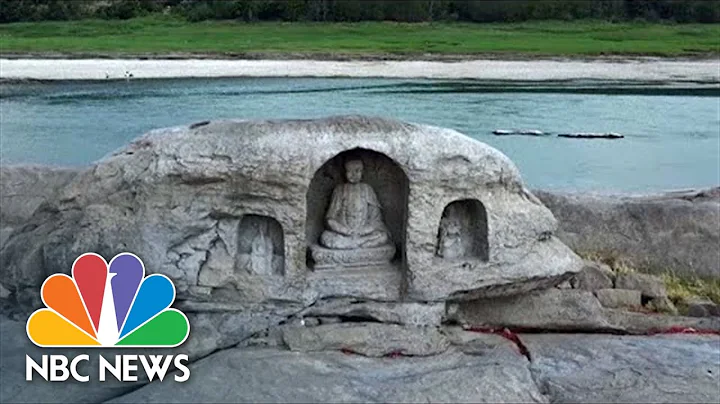Author | Leaning on the Pine and Listening to the Wind (Kong.com Shop: Hangzhou Nanshan Bookstore)
Source | Kongfuzi Old Book Network App News

Looking at the Yangtze River from the embankment outside the Xiaodongmen of Ezhou City , a super large reef protrusion can be seen a few hundred meters away Out of the center of the river, it winds like a dragon. According to legend in ancient times, there was a horned dragon hovering above it, "surrounding it for more than seventy feet, emerging in winter and disappearing in summer." It would disappear after accumulating days. This is "Longpanji".
What's even more amazing is that an ancient boat-shaped pavilion stands on top of the dragon's head. It floats like a boat and stands across the river. This is the amazing Ezhou Yangtze River Guanyin Pavilion .

Guanyin Pavilion was built in the Song Dynasty. I don’t know what its name was at that time. In the fifth year of the Yuan Dynasty (1345), Tieshan (a Mongolian official in the Yuan Dynasty), the governor of Wuchang, raised funds to rebuild it, and it was first named Guanyin Pavilion. It was repaired many times during the Ming and Qing Dynasties and the Republic of China.

According to the "Wuchang County Chronicles": "A temple was built in Longpanji during the Song Dynasty, which was prosperous and destroyed in the past dynasties. In the Yuan Dynasty, Longpan Temple was built again, also known as Guanyin Pavilion. In the Ming Dynasty, it was destroyed in the 6th year of Jiajing, and Xu Zhiqing, the later magistrate of the county, rebuilt it, with Guanlan Pavilion and Yinbin Tower. wait".

Guanyin Pavilion faces east and faces west. The pavilion is 24 meters long, 10 meters wide and 14 meters high. The base is more than 1 meter and is made of stone. The structure of the pavilion is a wooden frame pavilion-style building, built of green bricks, which blends naturally with the Longpanji stone. There are 1 pavilion, 3 halls and 1 floor in the
pavilion, with a total area of 419 square meters. The existing buildings from upstream to downstream are the three halls of Patriarch Hall, Guanyin Hall, Laojun Hall, , Chunyang Tower, Guanlan Pavilion and other buildings.

Entering the Guanyin Pavilion is the Dongfang Shuo Hall. Legend has it that when the Yangtze River flooded, Dongfang Shuo used his magical power to prevent the sacred turtles and dragons in the river from causing trouble. Therefore, people worshiped the statue of Dongfang Shuo in order to suppress the horizontal demons. The main hall in the middle of
is the Guanyin Hall, which enshrines the portrait of Guanyin Bodhisattva. The last major hall is the Taishang Laojun hall.
is called Guanyin Pavilion, and in fact Taoist gods are also enshrined. This kind of religious situation is extremely rare overseas, but it is often seen in China. In the Song Dynasty, only Guanyin was worshiped here. Later, some people believed that Taoism could ward off evil spirits, so they invited Taishang Laojun and the Eight Immortals into the Guanyin Pavilion. Later, they even invited Dongfang Shuo into the pavilion. After all, the Yangtze River is powerful and powerful.
According to legend, Guanyin Pavilion has three interesting features: old trees, divine eyes, and ancient wells.
The old tree refers to the canopy tree between the walls of the pavilion. There is a canopy of greenery between the walls of the pavilion; Shen Ao Yan has a popular story about Longpanji. There is a saying, "Ao fish blinks, the sky trembles and the earth trembles." In fact, it is a boring story broadcast by folk broadcasts. .
There is a patio between the Guanyin Hall and the Laojun Hall. There is an ancient well next to the patio. It seems to be cold when the cover is uncovered. The water level of the well water remains constant during flood periods and is generally clear. In the dry season, the well water is often higher than the river surface. Some people say that the source of the well water is not the Yangtze River water, but another water vein. However, in recent years, the ancient well has suddenly dried up for unknown reasons. The wonders of heaven and earth are difficult to fathom.
In addition, Guanyin Pavilion also has a drainage system. There is a hole at the lowest point of the whole attic. Whenever there is a flood, the water in the attic can be quickly drained away through this hole.
There are many records about floods flooding Guanyin Pavilion for thousands of years. Because the building is built on river rocks, the foundation is solid, and the building itself is mostly made of red stone and blue bricks. It is not afraid of blisters and can still stand tall despite being flooded.
In the 1998 flood, all three major halls on the first floor of Guanyin Pavilion were flooded, and the floodwaters soaked the windows of Chunyang Building on the second floor into the river. The most serious immersion occurred in 1954, when Guanyin Pavilion was almost destroyed. Before the completion of the Three Gorges Dam, Guanyin Pavilion was flooded every year. Since the completion of the dam, the flooding has been alleviated. However, the three major palaces are still flooded every year.
It can be said that every flood tide floods the pavilion, leaving only the high-rise windows, and even only the eaves, dragon's kiss, and middle pavilion in the vast Yangtze River. As soon as the flood season is over, the water comes out, and it emerges from the sky again, majestic in the center of the river.




![Yangtze River Cruise, China [Amazing Places 4K] - DayDayNews](https://i.ytimg.com/vi/K-WgENSRPCk/hq720.jpg?sqp=-oaymwEcCNAFEJQDSFXyq4qpAw4IARUAAIhCGAFwAcABBg==&rs=AOn4CLBrHqyduyXiLVHsmZ4M9scOOfYLQg)
















